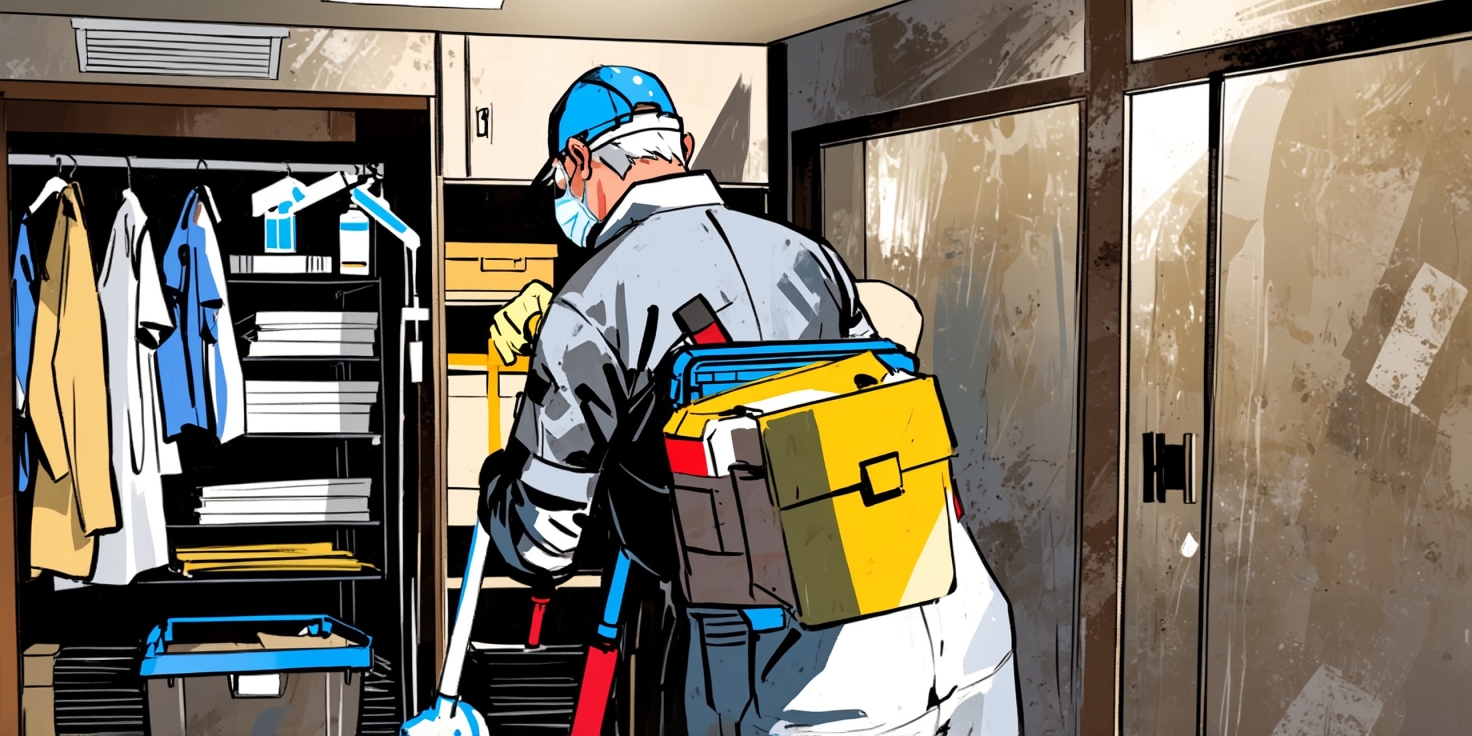Discovering mold in closets can be an unsettling experience for any homeowner. Not only does it pose potential health risks, but it can also indicate underlying moisture problems that may lead to more extensive property damage if left unaddressed. If you’ve recently found mold in your closet, it’s crucial to act quickly and effectively to prevent further spread and protect your belongings. At LMR Public Adjusters – South Florida’s premier public adjusters – we understand how stressful dealing with mold damage can be. Our dedicated team specializes in helping property owners navigate the complexities of mold insurance claims, ensuring you receive the maximum compensation you deserve. Whether you’re dealing with black mold, mildew, or hidden moisture issues, knowing what to do after discovering mold in closets is the first step toward restoring your home and peace of mind.
Identify the Source of Moisture
One of the most critical steps after discovering mold in closets is determining where the moisture is coming from. Mold thrives in damp, dark environments, and closets often provide the perfect conditions if moisture is present. Identifying and eliminating the source of moisture is essential to prevent mold from returning after cleanup.
Start by checking for common moisture sources such as leaky pipes, roof leaks, or high humidity levels. According to the Environmental Protection Agency (EPA), indoor humidity should be kept below 60% to prevent mold growth. Use a hygrometer to monitor humidity levels and consider installing a dehumidifier if needed.
“Mold can begin growing within 24 to 48 hours of water exposure,” warns the Centers for Disease Control and Prevention (CDC).
Here are some common sources of moisture to investigate:
- Leaking water pipes behind closet walls or ceilings
- Condensation from poor ventilation or HVAC systems
- Roof or window leaks near the closet area
- Flood damage or past water intrusion not properly dried
If you’re unsure about the source, consider hiring a professional to conduct a moisture inspection. For more information on how to handle such issues, visit our detailed guide on water damage and how it can lead to mold problems.
Additionally, our team at property claims can help you navigate insurance claims related to mold and moisture damage. Learn more about our services and expertise by visiting our About Us page or browse our helpful resources on our blog.
For further reading, the EPA offers a comprehensive guide on mold and moisture control: https://www.epa.gov/mold/mold-guide.
Remove All Items from the Closet
The first and most crucial step after discovering mold in your closet is to completely clear out the space. Mold thrives in dark, damp environments, and clothing, shoes, and storage boxes can trap moisture, making the problem worse. Removing all items allows you to assess the extent of the mold growth and prevents further contamination of your belongings. Be sure to wear protective gloves and a mask during this process to avoid inhaling mold spores or coming into direct contact with them.
Once everything is removed, inspect each item carefully. Wash clothes in hot water with a mold-killing detergent, and discard anything that shows signs of irreversible mold damage. This step is essential not only for salvaging your possessions but also for preventing the spread of mold to other areas of your home.
After clearing the closet, you’ll be better equipped to evaluate the damage and determine whether professional help is needed. If the mold appears extensive or has affected the structure of your home, consider reaching out to experts who specialize in mold damage and property claims. Acting quickly can help minimize long-term damage and health risks. For more guidance on how to handle mold and other types of home damage, visit our blog page for expert tips and advice.
Clean and Disinfect the Affected Area
Once mold is discovered in your closet, it’s crucial to thoroughly clean and disinfect the affected area to prevent further contamination and protect your health. Start by removing all items from the closet and inspecting them for mold. Discard anything that is heavily infested and cannot be salvaged. Use protective gear such as gloves, a mask, and goggles to avoid direct exposure to mold spores.
Next, clean all surfaces using a mixture of water and detergent or a commercial mold cleaner. Scrub walls, shelves, and flooring thoroughly, paying close attention to corners and hidden crevices where mold tends to thrive. After cleaning, disinfect the area with a solution containing at least 70% alcohol or a diluted bleach mixture to kill any remaining spores.
Ensure the closet is completely dry before placing items back. Use fans or a dehumidifier to speed up the drying process and reduce moisture levels, which helps prevent mold from returning. If the mold damage is extensive or keeps recurring, it may be time to consult professionals. Learn more about how mold can affect your property by visiting our mold damage page.
For additional support and guidance, our team at LMR Public Adjusters is here to help. Whether you’re dealing with mold, water damage, or other property issues, we provide expert assistance to ensure your home is safe and restored properly.
Dry the Closet Thoroughly
Once mold is discovered in your closet, one of the most critical steps is ensuring the area is completely dry. Mold thrives in damp, humid environments, so eliminating moisture is essential to prevent it from returning. Start by removing all items from the closet and using fans or a dehumidifier to circulate air and reduce humidity levels. If possible, open windows and doors to increase ventilation. Pay close attention to corners, baseboards, and any hidden areas where moisture may linger.
Use absorbent materials like towels to soak up any visible water, and consider using moisture-absorbing products such as silica gel or baking soda to draw out residual dampness. If the mold was caused by a leak or plumbing issue, it’s important to address the source immediately to avoid future problems. You may want to consult a professional to assess the extent of the damage, especially if it involves structural components or recurring leaks.
For more guidance on dealing with water-related issues, visit our page on water damage. If you’re unsure about the next steps or need help filing a claim, our team of experts is here to assist. Learn more about our services for property claims and how we can support you through the recovery process. Taking swift action to dry out your closet thoroughly can save you time, money, and stress in the long run.
Inspect and Clean Contaminated Belongings
After discovering mold in your closet, it’s crucial to thoroughly inspect and clean all contaminated belongings to prevent further spread and health risks. Start by removing every item from the affected area and examining them for visible mold growth or musty odors. Pay close attention to porous materials like clothing, shoes, and bags, as mold can easily penetrate these surfaces. Items that are heavily infested may need to be discarded to avoid cross-contamination.
For salvageable belongings, wash fabrics in hot water with a mold-killing detergent or vinegar solution. Leather goods and non-washable items should be cleaned using specialized mold removal products or taken to a professional cleaner. Ensure everything is completely dry before returning items to the closet, as moisture encourages mold regrowth.
While cleaning, wear protective gear such as gloves and a mask to avoid inhaling mold spores. It’s also wise to ventilate the area and use a HEPA vacuum to remove any lingering spores from surfaces. If the mold damage is extensive or keeps returning, it may be time to consult professionals who specialize in mold damage.
Understanding the root cause of the mold—often linked to hidden leaks or poor ventilation—is essential. For more insights on how to handle such issues, visit our detailed blog page or explore our property claims services to get expert help in managing mold-related damages.
Prevent Future Mold Growth
To ensure mold doesn’t return after removal, it’s essential to address the root causes and implement preventative measures. Start by improving ventilation in your closet. Use dehumidifiers or moisture absorbers to maintain a dry environment, especially in humid climates. Regularly inspect your home for signs of leaks or water intrusion, particularly around windows, roofs, and plumbing systems. If you’ve experienced water damage in the past, ensure it was thoroughly dried and treated to prevent lingering moisture.
Choose breathable storage containers and avoid overpacking closets, which can restrict airflow and trap humidity. Periodically clean and air out your closet to discourage mold spores from settling. Consider using mold-resistant paint or installing moisture barriers if your closet is prone to dampness.
If you’re unsure about the source of moisture or need professional help, consulting with experts can make a significant difference. Learn more about how we assist homeowners with property claims related to mold and water damage. Our team is experienced in identifying hidden issues and helping you recover damages effectively.
For more insights and helpful tips, visit our regularly updated blog page. Taking proactive steps now can save you from costly repairs and health risks in the future. Keep your home safe, dry, and mold-free with consistent maintenance and awareness.
Know When to Call a Professional
If you’ve discovered mold in your closet, it’s essential to assess the severity before deciding on the next steps. While small patches of surface mold can often be cleaned using household products, extensive growth or recurring mold issues may indicate a deeper problem, such as hidden water damage or poor ventilation. In such cases, calling a professional is not just recommended—it’s necessary.
Professional mold remediation experts have the tools and expertise to identify the source of the mold, safely remove it, and prevent it from returning. If you notice a musty odor, discoloration spreading beyond the closet, or if anyone in your household is experiencing unexplained allergies or respiratory issues, it’s time to seek expert help. Mold can compromise the structural integrity of your home and pose serious health risks if left untreated.
Additionally, if the mold is linked to a larger issue like a plumbing leak or roof damage, you may need to file a property insurance claim. In such situations, working with experienced property claims professionals can help you navigate the process and ensure you receive fair compensation. Learn more about how our team supports homeowners by visiting our About Us page. Don’t let mold damage escalate—knowing when to call in the experts can save you time, money, and stress in the long run.
In conclusion, discovering mold in your closet can be unsettling, but taking prompt and effective action can prevent further damage and protect your health. Start by removing affected items, thoroughly cleaning the area with appropriate solutions, and addressing the root cause of moisture. Ensuring proper ventilation and humidity control will help prevent future mold growth. If the problem is extensive or persistent, don’t hesitate to seek professional help. By staying proactive and informed, you can maintain a clean, safe, and mold-free home environment.




